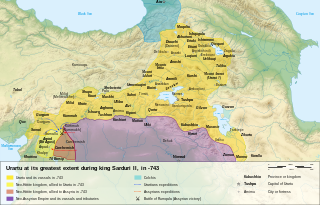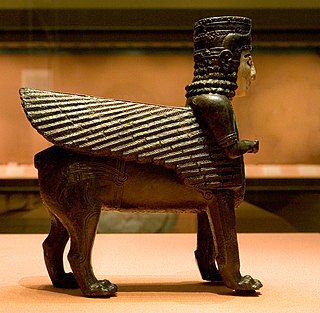Related Research Articles

The Hurrians were a people who inhabited the Ancient Near East during the Bronze Age. They spoke the Hurrian language, and lived throughout northern Syria, upper Mesopotamia and southeastern Anatolia.
Hurro-Urartian is an extinct language family of the Ancient Near East, comprising only two known languages: Hurrian and Urartian.

The Kura–Araxes culture was an archaeological culture that existed from about 4000 BC until about 2000 BC, which has traditionally been regarded as the date of its end; in some locations it may have disappeared as early as 2600 or 2700 BC. The earliest evidence for this culture is found on the Ararat plain; it spread north in the Caucasus by 3000 BC.

Diauehi (Modern Georgian: დიაოხიDiaokhi, Urartian Diauehi, Greek Τάοχοι Taochoi, Armenian Տայք Tayk, possibly Assyrian Daiaeni) was a tribal union located in northeastern Anatolia, that was recorded in Assyrian and Urartian sources during the Iron Age. It is usually (though not always) identified with the earlier Daiaeni(Dayaeni), attested in the Yonjalu inscription of the Assyrian king Tiglath-Pileser I's third year (1118 BC) and in later records by Shalmaneser III (845 BC). While it is unknown what language(s) they spoke, they may have been speakers of a Kartvelian, Armenian, Iranian, or Hurrian language.

The Trialeti–Vanadzor culture, previously known as the Trialeti–Kirovakan culture, is named after the Trialeti region of Georgia and the city of Vanadzor, Armenia. It is attributed to the late 3rd and early 2nd millennium BCE. The Trialeti–Vanadzor culture emerged in the areas of the preceding Kura–Araxes culture. Some scholars speculate that it was an Indo-European culture. It developed into the Lchashen–Metsamor culture. It may have also given rise to the Hayasa-Azzi confederation mentioned in Hittite texts,and the Mushki mentioned by the Assyrians.
David Marshall Lang, was a Professor of Caucasian Studies, School of Oriental and African Studies, University of London. He was one of the most productive British scholars who specialized in Georgian, Armenian and ancient Bulgarian history.

The Shulaveri–Shomu culture, also known as the Shulaveri-Shomutepe-Aratashen culture, is an archaeological culture that existed on the territory of present-day Georgia, Azerbaijan, and Armenia, as well as parts of northern Iran during the Late Neolithic/Eneolithic. It lasted from around the end of the seventh millennium BC to the beginning of the fifth millennium BC.
Godin Tepe is an archaeological site in western Iran, located in the valley of Kangavar in Kermanshah province. The importance of the site may have been due to its role as a trading outpost in the early Mesopotamian trade networks.
The origin of the Armenians is a topic concerned with the emergence of the Armenian people and the country called Armenia. The earliest universally accepted reference to the people and the country dates back to the 6th century BC Behistun Inscription, followed by several Greek fragments and books. The earliest known reference to a geopolitical entity where Armenians originated from is dated to the 13th century BC as Uruatri in Old Assyrian. Historians and Armenologists have speculated about the earlier origin of the Armenian people, but no consensus has been achieved as of yet. Genetic studies show that Armenian people are indigenous to historical Armenia, showing little to no signs of admixture since around the 13th century BC.

The prehistory of Georgia is the period between the first human habitation of the territory of modern-day nation of Georgia and the time when Assyrian and Urartian, and more firmly, the Classical accounts, brought the proto-Georgian tribes into the scope of recorded history.

The history of the Caucasus region may be divided by geography into the history of the North Caucasus (Ciscaucasia), historically in the sphere of influence of Scythia and of Southern Russia, and that of the South Caucasus in the sphere of influence of Persia, Anatolia, and Assyria.

The Urartu was an Iron Age kingdom centered around the Armenian highlands between Lake Van, Lake Urmia, and Lake Sevan. The territory of the ancient kingdom of Urartu extended over the modern frontiers of Turkey, Iran, Iraq, and the Republic of Armenia. Its kings left behind cuneiform inscriptions in the Urartian language, a member of the Hurro-Urartian language family. Since its re-discovery in the 19th century, Urartu, which is commonly believed to have been at least partially Armenian-speaking, has played a significant role in Armenian nationalism.

Archaeology in Armenia has revealed many significant historical findings. Armenia is rich in Bronze Age sites and several Stone Age sites were recently identified on the slopes of the Aragats Mountain and are currently being excavated by Armenian and international teams. Archaeological excavations have taken place in the territory which is now the Republic of Armenia for about 150 years. Many sites, ranging from Stone Age to Early Iron Age, have been discovered and at least partly excavated. For the preservation and reconstruction of archaeological sites in Armenia, suggestions, and solutions have been proposed by L. Kirakosyan from National University of Architecture and Construction of Armenia.

Argištiḫinili was a town in the ancient kingdom of Urartu, established during the expansion of the Urartians in the Transcaucasus under their king Argishti I, and named in his honour. It lasted between the 8th and 6th centuries BC. The ruins of the Argištiḫinili fortifications are 15 kilometres (9 mi) southwest of the present-day town of Armavir, Armenia, between the villages of Nor-Armavir and Armavir in the Armenian marz of Armavir. The town was founded on the left bank of the middle reaches of the Aras River. Over the centuries, the river channel has shifted to several kilometres south of the town.
Trialetian is the name for an Upper Paleolithic-Epipaleolithic stone tool industry from the South Caucasus. It is tentatively dated to the period between 16,000 / 13,000 BP and 8,000 BP.
Kul Tepe Jolfa is an ancient archaeological site in the Jolfa County of Iran, located in the city of Hadishahr, about 10 km south from the Araxes River.
Yanik Tepe is a Chalcolithic and Bronze Age archaeological site in East Azerbaijan province, Iran.
Marilyn Kelly-Buccellati is an American archaeologist, who focused her research on the Caucasus and ancient Syria in the third and second millennium B.C..
Lchashen-Metsamor culture is an archeological culture of the Late Bronze Age and Early Iron Age in the South Caucasus. It was mainly spread in areas of present-day Armenia. Lchashen-Metsamor pottery was also found in the Ağrı Province of Turkey and in southern Georgia.

Urartu religion is a belief system adopted in the ancient state of Urartu, which existed from the 8th to 6th centuries BC. It was typical of despotic states from the Near East. The Urartu religion was polytheistic in nature and derived from the earlier beliefs of Mesopotamia and Anatolia. As in other beliefs of the ancient Near East, Urartu had a pantheon of deities, patronizing various phenomena. The main deity was Haldi. The worlds of humans and gods were united through ritual sacrifices. The Urartu religion absorbed the motifs of the tree of life, the serpent and the winged solar disk characteristic of the ancient Near East. Against the background of Mesopotamian beliefs, Urartu was distinguished by a high level of religious tolerance, which was conditioned by the multinationality of the state.
References
- 1 2 Burney, Charles A. & David Marshall Lang. (2001) The peoples of the hills: Ancient Ararat and Caucasus. London: Phoenix Press. ISBN 1842122525
- ↑ Charles Burney, The Kingdom of Urartu (Van), p144, in Ancient Anatolia, 1998.
- ↑ Yanik Tepe, Northwestern Iran The Early Trans-Caucasian Period. Stratigraphy and Architecture. Peeters Publishers. Retrieved 27 September 2015.
- ↑ Yanik Tepe, Tabriz, Iran. Oxford Index. Retrieved 27 September 2015.
- ↑ A View from the Highlands: Archaeological Studies in Honour of Charles Burney. Peeters Publishers. Retrieved 27 September 2015.